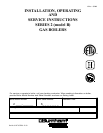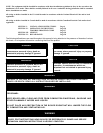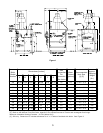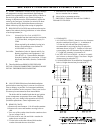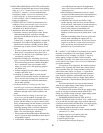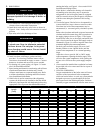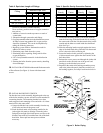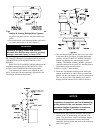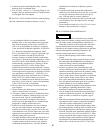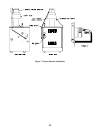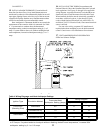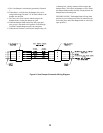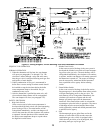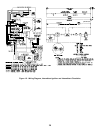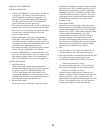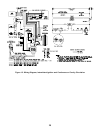
9
installed above the bottom of chimney to prevent
blockage.
G. Vent pipe should slope upward from draft hood to
chimney not less than one inch in four feet. No portion
of vent pipe should run downward or have dips or
sags. Vent pipe must be securely supported.
H. Vent pipe must be inserted into but not beyond inside
wall of chimney liner. Seal tight between vent pipe
and chimney.
I. Do not install non-listed (AGA, CGA, ETL or UL) vent
damper or other obstruction in vent pipe.
14. IF AN EXISTING BOILER IS REMOVED -
When an existing boiler is removed from a common
venting system, the common venting system is likely to be too
large for proper venting of the appliances remaining to it.
At the time of removal of an existing boiler, the follow-
ing steps shall be followed with each appliance remaining
connected to the common venting system placed in operation,
while the other appliances remaining connected to the
common venting system are not in operation:
A. Seal any unused openings in the common venting
system.
B. Visually inspect the venting system for proper size and
horizontal pitch and determine there is no blockage or
restriction, leakage, corrosion, and other deficiencies
which could cause an unsafe condition.
C. Insofar as is practical, close all building doors and
windows and all doors between the space in which the
appliances remaining connected to the common venting
system are located and other spaces of the building.
Turn on clothes dryers and any appliance not connected
to the common venting system. Turn on any exhaust
fans, such as range-hoods and bathroom exhausts, so
they will operate at maximum speed. Do not operate a
summer exhaust fan. Close fireplace dampers.
D. Place in operation the appliance being inspected. Follow
the Lighting (or Operating) Instructions. Adjust
thermostat so appliance will operate continuously.
E. Test for spillage at the draft hood relief opening after 5
minutes of main burner operation. Use the flame of a
match or candle, or smoke from a cigarette, cigar or
pipe.
F. After it has been determined that each appliance remain-
ing connected to the common venting system properly
vents when tested as outlined above, return doors,
windows, exhaust fans, fireplace dampers and any other
gas burning appliance to their previous conditions of use.
G. Any improper operation of the common venting system
should be corrected so the installation conforms with the
National Fuel Gas Code, NFPA 54/ANSI Z223.1. When
resizing any portion of the common venting system, the
common venting system should be resized to approach
the minimum size as determined using the appropriate
tables in Part 11 in the National Fuel Gas Code, NFPA
E. Continuous Ignition (Standing Pilot) Only. Remove
knockout from vent damper blade.
F. Size 202 Only. Install 4" x 3" reducing fitting on vent
damper outlet (or draft hood outlet for Canadian boiler
not equipped with vent damper).
13. INSTALL VENT CONNECTOR from reducing fitting
(202 Only), draft hood or damper to chimney, see Fig. 8.
A. Vent installation shall be in accordance with local
building codes; or the local authority having jurisdic-
tion; or the National Fuel Gas Code, ANSI Z223.1/
NFPA 54; or the Standard for Chimneys, Fireplaces,
Vents, and Solid Fuel Burning Appliances, ANSI/NFPA
211. Both of the aforementioned standards, ANSI
Z223.1 and ANSI/NFPA 211, specify Type B and Type
L double wall metal vents and fire clay tile lined
masonry chimneys as suitable chimney constructions
for Category I, draft hood equipped appliances, such as
this Series 2 boiler. Both standards prohibit the use of
unlined masonry construction as a chimney, with the
exception in ANSI Z223.1/NFPA 54 that "Where
permitted by the authority having jurisdiction, existing
chimneys shall be permitted to have their use continued
when an appliance is replaced by an appliance of similar
type, input rating, and efficiency." ANSI/NFPA 211
prohibits the use of single wall metal vent as a chimney,
while ANSI Z223.1 allows it under very restrictive
conditions. In Canada refer to the Natural Gas Installa-
tion Code, CAN/CGA-B149.1 or the LP Gas Installation
Code, CAN/CGA-B149.2 - latest edition.
B. Do not connect into same leg of chimney serving an
open fireplace.
C. Inspect chimney for obstructions or restrictions and
remove. Clean chimney if necessary.
D. Vent pipe to chimney must not be smaller than outlet
on draft hood or damper. Although single wall vent
pipe may be used, Type B is recommended. The
venting system must be arranged so that only the
boiler is served by the damper device. Installation per
paragraph 12 complies with this provision.
E. Where two or more appliances vent into a common
vent, the area of the common vent should at least
equal the area of the largest vent plus 50% of the area
in the additional vents. Do not connect the vent of this
appliance into any portion of mechanical draft system
operating under positive pressure.
F. Vent pipe should have the greatest possible initial rise
above the draft hood consistent with the head room
available and the required clearance from adjacent
combustible building structure. Vent Pipe should be



